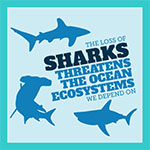It's Time to Protect Sharks and Manta Rays
CONTACTS:
Joanna Benn, international policy, U.S.: 202.540.6611; Thailand: +66.8.7096.0742
Rachel Brittin, global shark conservation, U.S.: 202.50.6312; Thailand: +66.8.7096.1095
It's big business, it's big news, it's a big vote. Will 2013 be the "Year of the Shark" at CITES?
Infographics: Every Vote Counts

Shark and manta ray populations are in decline due to international trade.
Starting this week (March 3-14), countries will have a chance to protect vulnerable shark and manta ray species at the meeting of the Convention on International Trade in Endangered Species of Wild Fauna and Flora (CITES) in Bangkok, Thailand.
Delegates should vote to regulate the international trade in porbeagle, oceanic whitetip, and hammerhead sharks (scalloped, great, and smooth), as well as manta rays by adding them to Appendix II of CITES meaning that trade will only be permitted if it is legal and sustainable.
CITES is widely recognized as one of the most effective and best-enforced international conservation agreements.
To learn more about the species up for debate and the meeting itself go to www.PewEnvironment.org/CITES and watch our new video below.






